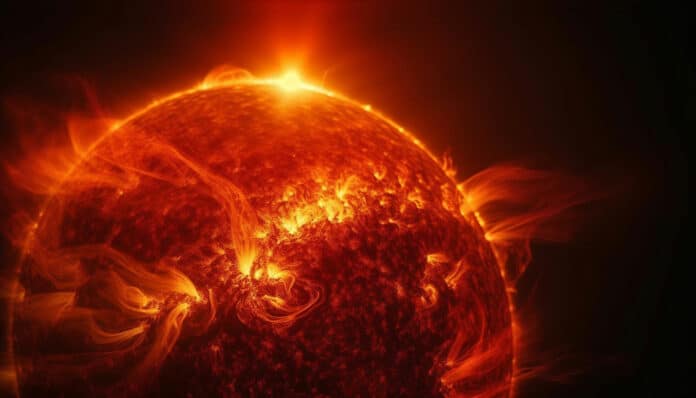The Hadean Aeon is when life most likely first emerged, but little is known about the environmental factors that influenced the chemistry’s complexity. To comprehend the beginning of abiogenesis, one must understand various ecological factors, including local (atmospheric, surface, and oceanic) and global (heliospheric) dynamics of the early Earth.
A new study suggests that the first building blocks of life on Earth may have formed because of eruptions from our Sun. Chemical experiments demonstrate how solar particles can create amino acids and carboxylic acids, the fundamental constituents of proteins and organic life, when collide with gases in Earth’s early atmosphere.
Stanley Miller of the University of Chicago attempted to mimic these primitive conditions in the laboratory back in 1953. Methane, ammonia, water, and molecular hydrogen—gases considered to be common in Earth’s early atmosphere—were added to a closed chamber by Miller, who then repeatedly ignited an electrical spark to mimic lightning.
Miller and his graduate advisor Harold Urey examined the chamber’s contents a week later and discovered that 20 different amino acids had developed. And that was a big revelation.
But the last 70 years have complicated this interpretation. Seeking alternative energy sources, some scientists pointed to shockwaves from incoming meteors, whereas others pointed toward solar ultraviolet radiation.
Vladimir Airapetian, a stellar astrophysicist at NASA’s Goddard Space Flight Center in Greenbelt, Maryland, and co-author of the new paper, pointed to energetic particles from our Sun. His idea arises after observing data from NASA’s Kepler mission.
A study by Airapetian published in 2016 claimed that the Sun was 30% dimmer during the first 100 million years of Earth’s existence. However, huge eruptions known as solar “superflares”—which we now only see once every 100 years or so—would have occurred every 3–10 days. These superflares launch particles traveling at close to light speed, frequently hitting our atmosphere and igniting chemical reactions.
After publishing the paper, the Yokohama National University in Japan team contacted Airapetian.
Airapetian said, “Dr. Kobayashi, a professor of chemistry there, had spent the last 30 years studying prebiotic chemistry. He was trying to understand how galactic cosmic rays – incoming particles from outside our solar system – could have affected early Earth’s atmosphere. “Most investigators ignore galactic cosmic rays because they require specialized equipment, like particle accelerators.”
“I was fortunate to have access to several of them near our facilities. Minor tweaks to Kobayashi’s experimental setup could put Airapetian’s ideas to the test.”
Airapetian, Kobayashi, and their collaborators created a mixture of gases matching early Earth’s atmosphere as we understand it today. They combined carbon dioxide, molecular nitrogen, water, and a variable amount of methane. They shot the gas mixtures with protons or ignited them with spark discharges (simulating lightning), replicating the Miller-Urey experiment for comparison.
The mixes launched by protons (solar particles) produced measurable levels of amino acids and carboxylic acids as long as the methane fraction was over 0.5%. But before any amino acids could develop, the lightning’s spark discharges needed a methane concentration of roughly 15%.
Airapetian added, “And even at 15% methane, the production rate of the amino acids by lightning is a million times less than by protons. Protons also tended to produce more carboxylic acids (a precursor of amino acids) than those ignited by spark discharges.”
“All else being equal, solar particles appear to be a more efficient energy source than lightning. But all else likely wasn’t equal.”
Miller and Urey assumed that lightning was just as common at the time of the “warm little pond” as it is today. But lightning, which comes from thunderclouds formed by rising warm air, would have been rarer under a 30% dimmer Sun.
Airapetian said, “During cold conditions, you never have lightning, and early Earth was under a faint Sun. That’s not saying it couldn’t have come from lightning, but lightning seems less likely now, and solar particles seem more likely.”
Journal Reference:
- Kensei Kobayashi et al. Formation of Amino Acids and Carboxylic Acids in Weakly Reducing Planetary Atmospheres by Solar Energetic Particles from the Young Sun. Life. DOI: 10.3390/life13051103
